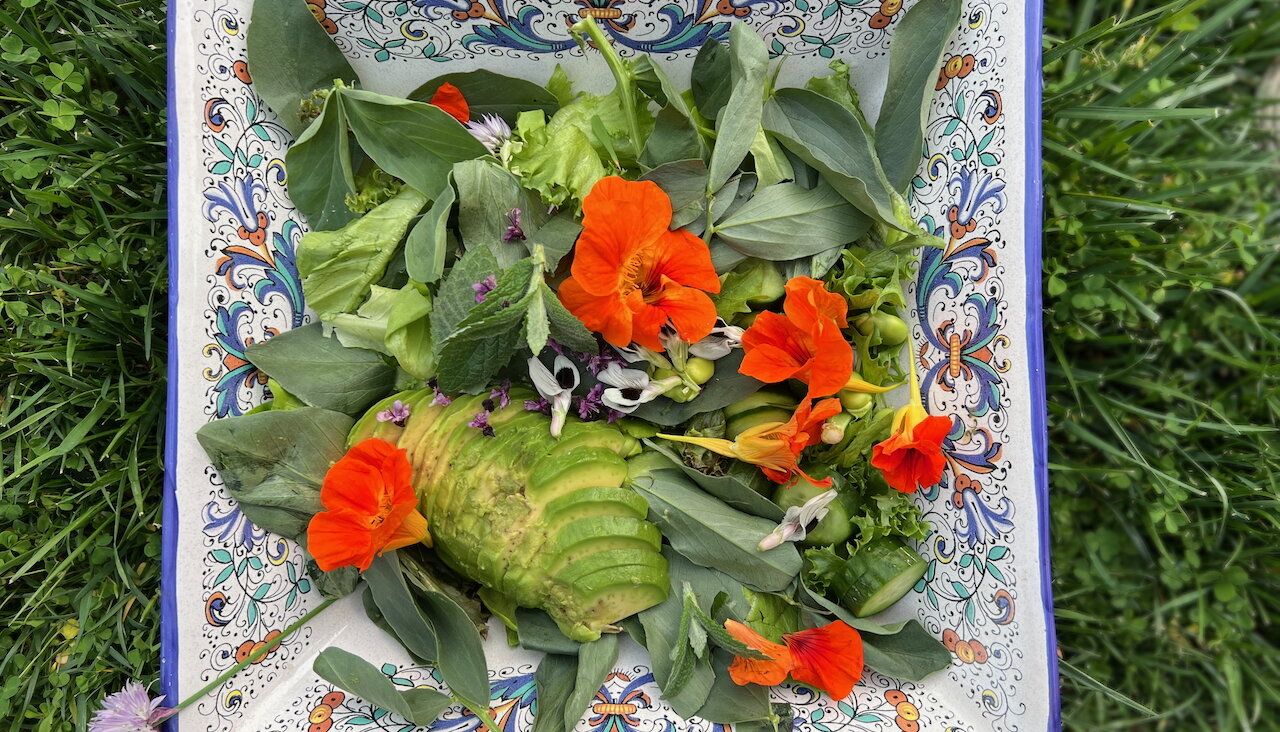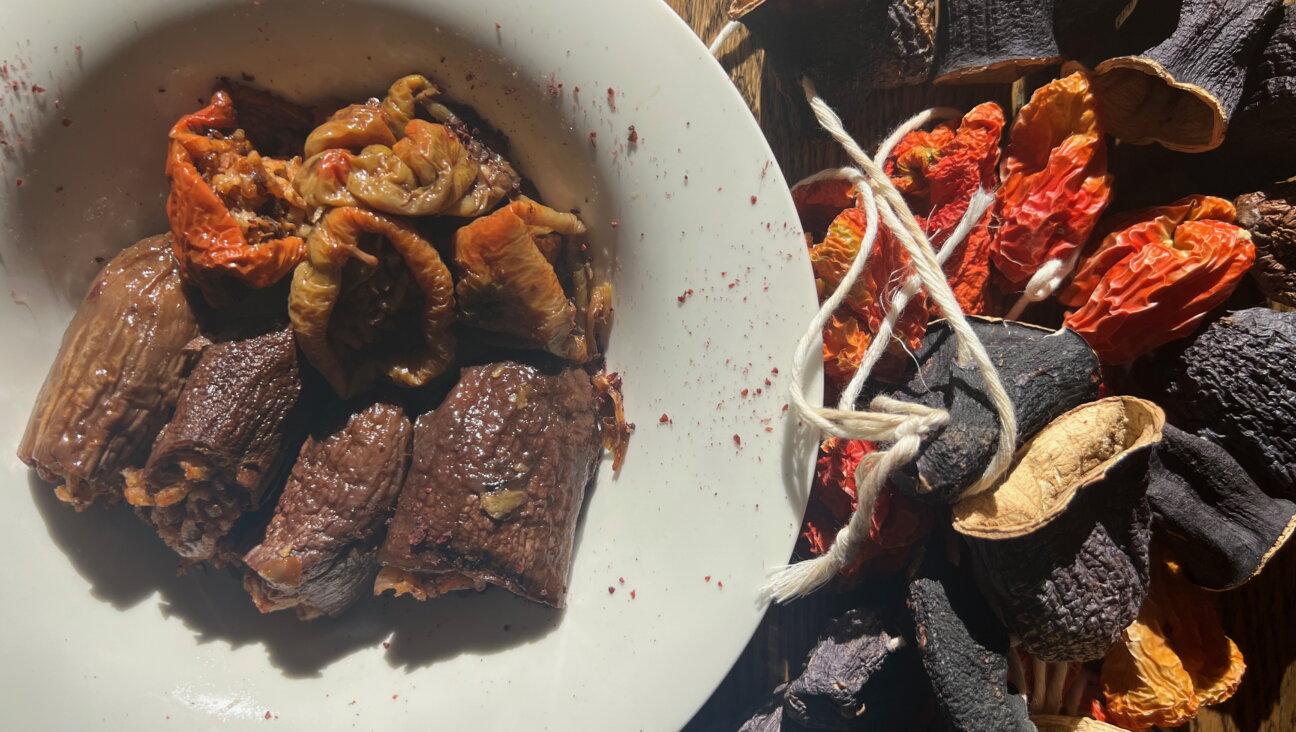5 Dishes. 5 Stories. So Jewish.

Ron Arazi’s hand-rolled couscous with tongue and chickpea stew. Image by Caleigh Waldman
The smell of schmaltz-popped corn greeted the noisy crowd filing up the stairs of the Henry Street Settlement on the Lower East Side last week. The draw? A Moth-like storytelling event, with food, called “Schmaltzy: 5 dishes. 5 stories. So Jewish.”
The brainchild of Jewish Food Society founder Naama Shefi, the organization’s first public event consisted of a handful of local bubbies, chefs and food mavens telling tales of recipes that influenced their lives, followed by a feast for the standing-room only audience of hungry tasters.

Jewish Food Society founder Naama Shefi Image by Lewis Kassel
Supporting the Society’s mission to honor and revitalize Jewish culinary traditions, Shefi, along with Jewish Food Society Program Director Ellie Backer, developed the event as a way to showcase the diversity of Jewish food and culture in an engaging and meaningful way. She explained, “I believe that recipes carry with them the marrow of who we are as individuals, families and as a people, and the stories of where we come from.”
Mitchell Davis, executive vice president of the award-granting and food-leader-fostering James Beard Foundation, emceed with short jokes and anecdotes (and even a Tai Chi-style stretch) in between each chapter. He kicked everything off with a statement that captured the spirit of the evening: “Food without story is just calories.”

James Beard Foundation Executive Vice President Mitchell Davis. Image by Lewis Kassel
This sentiment made the event site that much more relevant. The Henry Street Settlement was established in 1892 — around the same time that Sydney Taylor’s “All-in-the-Kind Family” took place — as a community center providing social services to the mostly impoverished immigrant families who had settled in the area. The majority of these families at the time were Ashkenazi Jews fleeing Eastern Europe to live in overcrowded tenements in a New World shtetl. Lilian Wald, Henry Street’s founder, viewed the arts as being as essential to the human experience as food, shelter and clothing. It’s easy to imagine how she would have felt about Schmaltzy.
But, on to the stories and the treats.
While the name of the event itself — schmaltzy — might lead you to think that the stories would be overly sentimental, Shefi used the riff on chicken fat to send the message that the event was meant to be fun and playful, and wouldn’t take itself too seriously.
With titles like “Why Yemenite shabbos is good for your belly but bad for your social life” and “How a torch was passed from mother to daughter through a dumpling,” the narratives ranged from comical to touching to inspirational.

The Gefilteria’s Liz Alpern created gin cocktails called she called Dirty Henrys. Image by Ilan Benatar
Though growing up in a non-cooking family, Liz Alpern related to food through Shabbat meals, and, inspired by a pastry in Paris, eventually started a challah-baking company in college. A few years later, she dedicated herself to revitalizing and reinventing Ashkenazi recipes, co-founding the Gefilteria and co-authoring The Gefilte Manifesto. At the event, Alpern developed the recipe for a “Dirty Henry” cocktail (gin, floral St. Germaine, pickle juice, lemon juice and a pickled dilly bean) and served roasted garlic–potato knishes with mustard.
Motivated by the produce his family grew in each new home as they migrated from Germany to Israel to the U.S., serial entrepreneur Idan Cohen recently founded Grow to help people raise their own food. He now cultivates tomatoes and cucumbers on his own rooftop and his daughter’s first word was גג — roof. Cohen prepared schichttorte, an Austro-Hungarian cake with layers of marzipan, coffee merengue and jam, a recipe that his grandmother carried from the old country and passed down through the generations.

Einat Admony slices the Yemenite Shabbat bread called kubaneh. Image by Caleigh Waldman
Even though her mother was the main cook at home, Chef Einat Admony, owner of Taim, Balaboosta and Bar Bolonat, remembers fondly her late father’s signature dish: the spicy Yemenite condiment s’chug that he made by processing garlic, multiple chili varieties and cilantro in a meat grinder. He was such a fanatic for the tear-inducing sauce that he brought it to restaurants (slipped into his wife’s purse) on the rare occasions when the family ate out. Admony served the Yemenite overnight-baked Shabbat bread kubaneh, alongside grated tomatoes, hilbeh (a bitter fenugreek sauce), tea-stained ten-hour eggs and, of course, a big dollop of s’chug.

Einat Admony’s kubaneh and schug. Image by Caleigh Waldman
Growing up in Riga, Latvia, Anna Gershenson cooked traditional Jewish foods alongside her mother who, despite losing her family as a teenager, was always vivacious and fun in the kitchen at a time when the Soviet Union frowned upon holiday celebrations. Gershenson eventually moved to western Massachusetts — her mother, husband and daughter in tow — and became a caterer and culinary educator. After her mother passed away, one of Gershenson’s first catering jobs was to prepare for a local family a traditional Jewish meal for Rosh Hashanah. Given her passion for nutrition, whole foods and healthy eating, she adapted her mother’s beef kreplach with a lighter chicken filling for an American palate, and realized that she had now stepped into the role of matriarch of her own family. Gershenson shared her kreplach not only with the crowd at Schmaltzy but with readers of New York Magazine in a grandma versus grandma battle of the dumplings.
Ron Arazi grew up in Israel as part of a large Moroccan-Lebanese family, which meant that he never cooked for or ate by himself. When he and his wife, Leetal, a pastry chef and photographer, moved to Brooklyn, they found themselves sitting down to the Passover seder with as many diners as sons mentioned in the Haggadah, nostalgic for the hustle and bustle of a large table. To ward off the isolation of being in a new city and to share their culinary heritage, the couple founded New York Shuk, hand-rolling couscous in the nascent Smorgasburg outdoor food market. Through their couscous and cooking classes, the Arazis helped customers get a taste of home and surrounded themselves with a new community. They served their famous couscous with a tongue-and-chickpea stew and a healthy dose of rose-inflected harissa.

A drawing by illustrator Flash Rosenberg, who illustrated the talks in real time. Image by Flash Rosenberg
If you missed last week’s storytelling, the Jewish Food Society will be adding to its website videos, recipes and the visual representation of each teller’s story, drawn extemporaneously by illustrator Flash Rosenberg. A series of more Shmaltzy-like events is in the works. Who knows, maybe you’ll be up on stage next.
Gayle Squires is a food writer, recipe developer and photographer. Her path to the culinary world is paved with tap shoes, a medical degree, business consulting and travel. She has a knack for convincing chefs to give up their secret recipes. Her blog is KosherCamembert
The Forward is free to read, but it isn’t free to produce

I hope you appreciated this article. Before you go, I’d like to ask you to please support the Forward.
Now more than ever, American Jews need independent news they can trust, with reporting driven by truth, not ideology. We serve you, not any ideological agenda.
At a time when other newsrooms are closing or cutting back, the Forward has removed its paywall and invested additional resources to report on the ground from Israel and around the U.S. on the impact of the war, rising antisemitism and polarized discourse.
This is a great time to support independent Jewish journalism you rely on. Make a gift today!
— Rachel Fishman Feddersen, Publisher and CEO
Support our mission to tell the Jewish story fully and fairly.
Most Popular
- 1

Fast Forward Ye debuts ‘Heil Hitler’ music video that includes a sample of a Hitler speech
- 2

Culture Cardinals are Catholic, not Jewish — so why do they all wear yarmulkes?
- 3

News School Israel trip turns ‘terrifying’ for LA students attacked by Israeli teens
- 4

Fast Forward Student suspended for ‘F— the Jews’ video defends himself on antisemitic podcast
In Case You Missed It
-

Fast Forward Police clash with pro-Palestinian protesters in Brooklyn as Columbia library takeover fallout continues
-

Opinion This week proved it: Trump’s approach to antisemitism at Columbia is horribly ineffective
-

Yiddish קאָנצערט לכּבֿוד דעם ייִדישן שרײַבער און רעדאַקטאָר באָריס סאַנדלערConcert honoring Yiddish writer and editor Boris Sandler
דער בעל־שׂימחה האָט יאָרן לאַנג געדינט ווי דער רעדאַקטאָר פֿונעם ייִדישן פֿאָרווערטס.
-

Fast Forward Trump’s new pick for surgeon general blames the Nazis for pesticides on our food
-
Shop the Forward Store
100% of profits support our journalism
Republish This Story
Please read before republishing
We’re happy to make this story available to republish for free, unless it originated with JTA, Haaretz or another publication (as indicated on the article) and as long as you follow our guidelines.
You must comply with the following:
- Credit the Forward
- Retain our pixel
- Preserve our canonical link in Google search
- Add a noindex tag in Google search
See our full guidelines for more information, and this guide for detail about canonical URLs.
To republish, copy the HTML by clicking on the yellow button to the right; it includes our tracking pixel, all paragraph styles and hyperlinks, the author byline and credit to the Forward. It does not include images; to avoid copyright violations, you must add them manually, following our guidelines. Please email us at [email protected], subject line “republish,” with any questions or to let us know what stories you’re picking up.















